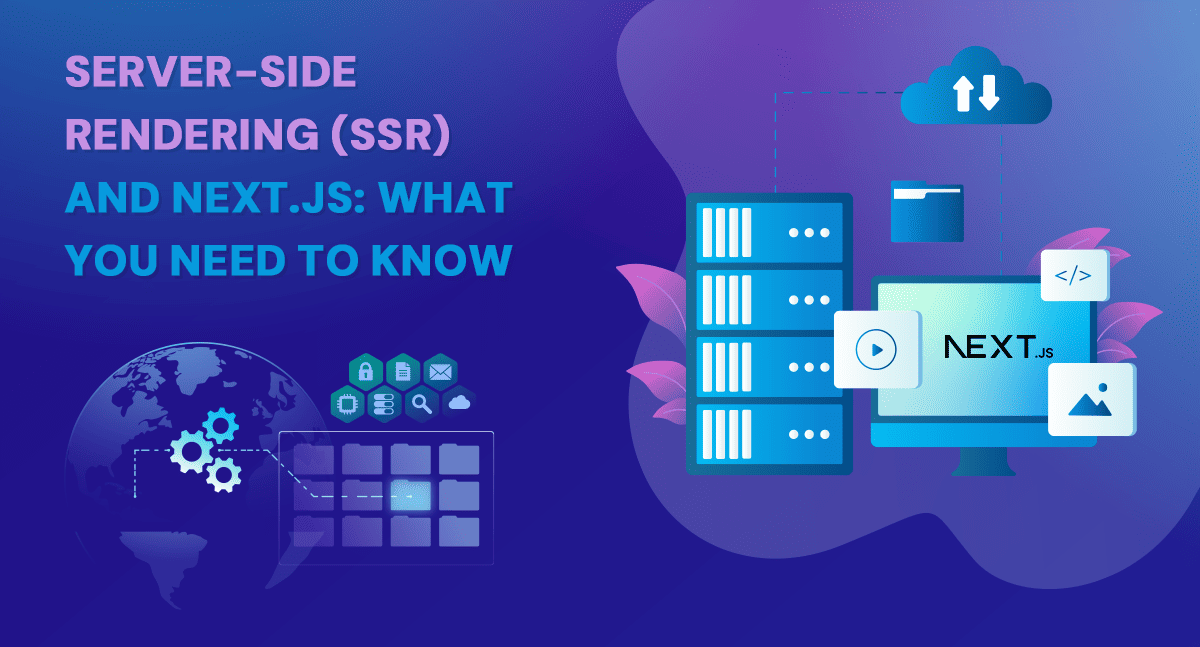Server-Side Rendering (SSR) and Next.js: What You Need to Know

Server-Side Rendering (SSR) and Next.js: What You Need to Know
Imagine being frustrated by slow-loading websites that make you wait endlessly. Picture this: you stumble upon a beautifully designed website showcasing an enticing product, only to be disappointed with its sluggish loading speed. It's exasperating, isn't it? Well, the good news is that your website's performance can undergo a revolution with Server-Side Rendering (SSR) using Next.js.
This article examines the world of SSR and Next.js, uncovering their power and benefits for business. This article's readers will understand why SSR goes beyond being a mere buzzword and becomes a game-changer for online presence.
Ready to supercharge your website's performance? Embark on a fascinating journey into Server-Side Rendering (SSR) and Next.js. Join us now!
What is Server-Side Rendering?
Server-side rendering (SSR) is a technique used in web development. In SSR, the server takes charge of generating the complete HTML content for a web page and then sends it to the client. The client's browser displays the fully rendered page, initially rendered on the server. This ensures the client receives a ready-to-display page without additional rendering.
Benefits of Server-Side Rendering
- SSR (Server-Side Rendering) improves webpage performance by reducing the loading time. It accomplishes this by sending a pre-rendered page to the client, resulting in faster load times and an enhanced user experience.
- With SSR, users can enjoy a faster content delivery experience as the server provides them with a pre-rendered page. This efficient process significantly reduces waiting time for page loading, resulting in increased user engagement and reduced bounce rates.
- SSR has numerous benefits for users with slower internet connections or older devices that may struggle with rendering client-side heavy applications. By rendering the page on the server, it ensures a more inclusive experience for all users, improving accessibility.
How Server-Side Rendering Works
- The server generates HTML by utilizing the retrieved data. This process involves the server rendering the dynamic content of the page and integrating it into the HTML structure.
- Once the page has finished loading, the interactive components or scripts necessary for user interactions are initialized by the client's browser.
Introduction to Next.js
Next.js, a widely used JavaScript framework, offers a comprehensive solution for server-side rendering (SSR) and building modern web applications. Developers often choose Next.js due to its unique blend of simplicity and flexibility, enabling them to enhance website performance and improve user experience.
With Next.js development, you can develop applications that render on the server before being sent to the client, unlike traditional client-side rendering (CSR) frameworks. This means the server processes and pre-renders the pages, delivering fully formed HTML content to the user's browser. As a result, users can see the initial content more quickly, leading to improved loading times and perceived performance.
But why is server-side rendering such a game-changer?
- SSR with Next.js provides enhanced SEO benefits. One key advantage is its positive impact on search engine optimization (SEO). By rendering HTML on the server, search engine crawlers can easily read and index your website's pages. As a result, your business has a higher chance of ranking in search engine result pages (SERPs), leading to increased visibility and organic traffic.
- Server-side rendering improves website performance by accelerating initial loading times. By generating and delivering a complete HTML document to the user's browser, the need for additional server requests is eliminated, reducing latency and significantly improving the overall user experience. The importance of optimal performance cannot be overstated as users tend to abandon websites with slow loading speeds. Thus, prioritizing performance becomes indispensable in establishing a successful online presence.
- A better user experience is achieved through Next.js, which delivers pre-rendered pages to the client. This approach ensures that users can quickly access meaningful content, reducing waiting times for page loads and enhancing user engagement. The result is a seamless browsing experience with faster loading times and smoother transitions. With these improvements, visitors are encouraged to stay on your website longer and explore further.
- Access and SEO Integration are key features of Next.js. It has built-in support for managing metadata, including title tags and meta descriptions. This empowers you to optimize your web pages for search engines, ensuring higher visibility in online searches. Moreover, Next.js offers extensive accessibility features that make your website easily discoverable and user-friendly for individuals with disabilities. Recognizing the ethical importance of accessibility also positively impacts your search engine rankings.
Best practices for Server-Side Rendering with Next.js
Server-Side Rendering (SSR) is a technique known for its ability to enhance website performance and user experience significantly. When implemented correctly using Next.js, SSR can elevate your web application to new heights. To ensure optimal results, consider these best practices when utilizing SSR with Next.js:
- Utilizing Incremental Static Generation (ISG) is a feature offered by Next.js. It enables the pre-generation of static pages during build time while also allowing dynamic fetching and updating at runtime. This approach delivers the advantages of both server-side rendering (SSR) and static site generation, resulting in fast-loading pages that seamlessly incorporate real-time data updates.
- Third-party website development becomes more user-friendly with Next.js as it offers seamless client-side navigation. This feature boosts the overall user experience by minimizing page reloads. By seamlessly integrating server-side rendering (SSR) with client-side routing, you can ensure smooth transitions and faster navigation between pages while still enjoying the advantages of SSR.
- In an SSR setup, optimizing images and assets becomes even more crucial. With the help of Next.js, you can take advantage of its built-in image optimization capabilities. This allows for automatic optimization and delivery of images in the most efficient format and size tailored to the device's screen resolution.
- To enhance the readability, the sentence can be improved as follows: "Optimize Non-Dynamic Content with Static Site Generation (SSG): While SSR is ideal for dynamic content, consider employing Static Site Generation (SSG) for website sections that do not require frequent updates. SSG generates static HTML pages prior to deployment, resulting in exceptionally fast loading speeds for static content."
- The performance of your SSR-enabled Next.js application should be regularly monitored and analyzed. Utilize tools like Google Lighthouse or WebPageTest to identify areas for improvement. By optimizing your code based on the insights gained, you can ensure fast load times and an exceptional user experience.
- Optimizing server response time is crucial regarding the advantages of Server-Side Rendering (SSR). One notable benefit of SSR is its ability to generate and serve HTML pages on the server side. To ensure optimal performance, various techniques can be implemented:
- Efficient caching mechanisms on the server side can significantly enhance response time.
- Optimizing database queries aids in reducing latency.
- Leveraging Content Delivery Network (CDN) services contributes to faster content delivery.
Conclusion
Server-Side Rendering (SSR) is a technique that allows websites to execute their entire code on the server rather than in the browser. Among the popular SSR libraries available, Next.js stands out for its extensive feature and versatile applications spanning websites, mobile apps, and APIs. This article explores how leveraging Next.js and SSR can positively impact your business. Additionally, we provide a comprehensive guide on implementing Next.js and SSR on your website. Stay connected for insightful details about SSR and Next.js!




